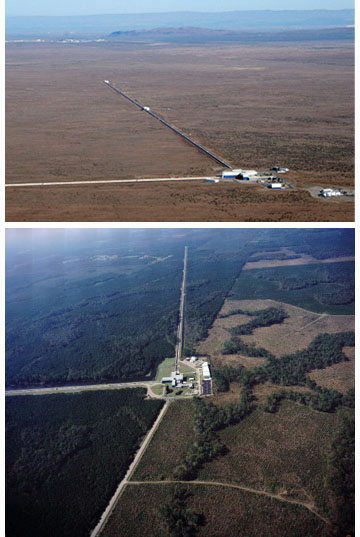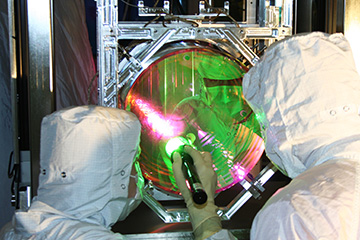![]()
A LIGO technician examines one of the facility’s mirrors. A research team recently used precise measurements enabled by the LIGO lasers and mirrors to cool a 10-kg object to near its quantum ground state of motion. [Image: Matt Heintze/Caltech/MIT/LIGO Lab]
The Laser Interferometer Gravitational-wave Observatory (LIGO) has already produced a string of landmarks in astrophysics—the first detection of gravitational waves, for example, and observations of distant, colliding neutron stars. Now, a research team at the behemoth facility has found another use for it: bringing an object with the same mass as a medium-sized dog close to its quantum ground state of motion (Science, doi: 10.1126/science.abh2634).
In a tour-de-force experiment, the LIGO team used the precision enabled by the facility’s lasers to cool the collective motion of its four suspended, 40-kg mirrors—which together form a 10-kg mechanical oscillator—to a frigid 77 nanokelvins (nK). That’s only a whisker above 10 nK—the temperature at which all thermal/vibrational motion in such a 10-kg “object” would have ceased.
The feat represents the first time that so large an object has been pushed so close to its motional ground state. And the researchers believe it opens up new prospects in studying gravity’s effect on large-scale quantum objects.
Thinking big
For years, researchers have used lasers to cool atoms, molecules and even very small objects to super-low temperatures—for instance, by using radiation pressure from the laser photons to adjust the momentum of the particle in question. Such techniques have already enabled ground-state cooling of particles at the nanoscale. Last year, for example, a team of scientists in Austria used a form of laser cooling to bring an optically trapped, 150-nm-diameter silica nanoparticle from room temperature to its quantum motional ground state.
The research team behind the new work realized that the unique characteristics of observatories such as LIGO and Virgo opened the opportunity to think much bigger. These observatories are giant, incredibly precise laser interferometers designed to sniff out gravitational waves—vanishingly small ripples in spacetime, emanating from astrophysical events millions of light years away.

The LIGO facilities in Hanford, Washington (top), and Livingston, Louisiana (bottom), showing the long interferometer arms.
The LIGO facilities—one in the state of Louisiana and the other in the state of Washington—each include two interferometer arms containing 4-km-long Fabry-Pérot cavities. At either end of each cavity is a 40-kg mirror or “test mass,” suspended on fused silica wires. As a gravitational wave ripples past planet Earth, it nudges these chunky mirrors by a tiny amount, effectively shortening one interferometer arm and lengthening the other. The relative length change, and thus the presence of the passing gravitational wave, shows up via changes in the interference of laser beams bouncing between the two sets of mirrors.
Detecting these infinitesimal changes requires an instrument of extraordinary sensitivity. In one commonly cited factoid, the Advanced LIGO facilities can sense displacements on the order of less than a thousandth of the width of a proton. And recent upgrades to the facilities, including the use of quantum “squeezed light,” have pushed their sensitivity still further. That sensitivity and the presence of the massive, suspended mirrors, the research team realized, offered a chance for a most unusual experiment in quantum ground-state cooling.
Four mirrors, one oscillator
The first step in the experiment was some basic mathematics. It turns out that the differential motion of the two 40-kg mirrors suspended, pendulum-like, at each end of either interferometer arm is equivalent to the motion of single, 20-kg mechanical oscillator. In turn, by similar math, the differential motion of these 20-kg mechanical oscillators in the two separate interferometer arms forms a single mechanical oscillator with a reduced mass of 10 kg.
The experiment’s objective was to cool the motion of this 10-kg “object” close to its ground state. This would be accomplished by carefully adjusting the relative thermal motion of each of the four massive 40-kg mirrors.
A different kind of laser cooling
LIGO’s powerful lasers would form a crucial part of the experiment. But here, the lasers would play a different role than in conventional laser cooling, in which the laser directly slows the motion of an atom or particle. Instead, the laser photons in the LIGO experiment would act as a continuous, ultraprecise source of information about the thermal motion of the suspended mirror at any given instant.
Armed with that information—as read in the interferometry signal between the two laser cavities—the researchers would then calculate a damping force specifically tuned to counteract the mirror motion sensed by the lasers. The damping force would be applied to the mirrors electrostatically, by varying the voltage in gold electrodes etched into a separate “reaction mass” located behind each mirror. The result, in principle, would be a continuous feedback loop—sensing of mirror motion by the laser, and a counteracting electrostatic push of the mirror in the other direction—that would steadily reduce the combined mirror system’s thermal motion, pushing it closer and closer to its motional ground state.
To make the scheme work, however, the researchers had to address another quandary. The very radiation pressure of the laser photons, pinging against the mirror surface to measure its instantaneous motion, can itself produce new thermal motion in the mirror, a phenomenon known as measurement back-action. The team reckoned, though, that it could overcome this added source of quantum decoherence by reading its impact in real time in the interferometer record and tweaking the feedback-cooling adjustments accordingly.

[Image: Caltech/MIT/LIGO Lab]
Kicking out the phonons
The researchers put their experimental design to the test last September, during a period of downtime at the LIGO facilities.
To measure how well the experiment had succeeded, the team calculated the 10-kg oscillator’s average “phonon occupation”—that is, the average number of phonons, or quanta of thermal/vibrational energy, that are rattling around in the system at any given time. At the start of the experiment, with the mirror masses at room temperature, the researchers estimated the 10-kg oscillator included trillions of these vibrational quanta. By the experiment’s end, based on the measured physical displacement, the researchers calculated that they had reduced that number to fewer than 11 phonons in the entire 10-kg oscillator system.
That’s equivalent, the team says, to reaching an effective temperature of 77 nK, and “sets a new record for the quantum state purity … for an object of such large mass.” Indeed, the authors write that the feat represents “a 13 orders-of-magnitude increase in the mass of an object prepared close to its motional ground state.”
Toward a new quantum view of large objects
The researchers stress, however, that the experiment is much more than just a (very large scale) parlor trick. The ability to put so resolutely macroscopic an object into a near-quantum state could allow scientists to explore the interaction of gravity and quantum objects, a long-standing but elusive goal.
“Nobody has ever observed how gravity acts on massive quantum states,” the study’s corresponding author, Vivishek Sudhir of the Massachusetts Institute of Technology, USA, noted in a press release accompanying the result. “This finally opens the door to an experimental study of how gravity might affect large quantum objects, something hitherto only dreamed of.”
